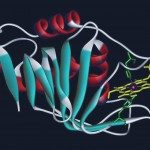Lien vers Pubmed [PMID] – 10512722
J. Mol. Biol. 1999 Oct;293(1):139-50
NF-kappaB is involved in the transcriptional regulation of a large number of genes, in particular those of human immunodeficiency virus (HIV). Recently, we used NMR spectroscopy and molecular modelling to study the solution structure of a native duplex related to the HIV-1 kappaB site, together with a mutated duplex for which a three base-pair change abolishes NF-kappaB binding. The native duplex shows unusual dynamics of the four steps surrounding the kappaB site. Here, we explore the intrinsic properties of the NMR-refined structures of both duplexes in order to understand why the native sequence is recognised by NF-kappaB among other DNA sequences. We establish that only the native kappaB site can adopt a conformation where its structure (curvature and base displacement), the accessibility and the electrostatic potentials of key atoms become very favourable for binding the large loops of NF-kappaB, in contrast to the mutated duplex. Finally, we show that the neutralisation of phosphate groups contacted by NF-kappaB favours a more canonical DNA structure. These findings lead to a new hypothesis for specific recognition through the phosphodiester backbone dynamics of the sequences flanking a binding site. Such unusual behaviour confers upon the overall duplex properties that can be used by NF-kappaB to select its binding site. Thus, the selectivity determinants for NF-kappaB binding appear to depend on deformability of an “extended” consensus sequence.

